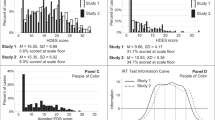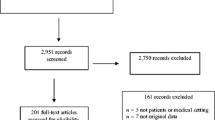Abstract
Background
Improvements in provider-patient relationships may help alleviate health disparities. Provider-patient race concordance and provider self-disclosure are variables that may help improve this relationship.
Purpose
This study sought to answer if provider-patient race concordance and provider self-disclosure may improve patient trust, rapport, similarity, likeability, intention to disclose, satisfaction, behavioral intention to keep a provider, and intention to recommend a provider, while using empathy as a covariate.
Methods
Using 882 White or Black participants, the current research used a 2 × 2 online experimental design. Participants were asked to read a vignette in which they were told they had borderline high cholesterol and needed to eat a healthier diet, by either a Black or White male physician, who either self-disclosed or did not self-disclose regarding their own struggle to eat a healthy diet. After reading this vignette, participants were surveyed regarding the dependent variables of interest.
Results
Participants in a Black concordant dyad reported higher levels of similarity than those in any other dyad. Provider self-disclosure led to higher levels of trust, rapport, similarity, likeability, intention to disclose, satisfaction, behavioral intention to continue using the provider, and intention to recommend the provider. No interaction effects were found.
Conclusion
While it is possible, based on past research, that race-concordant pairings may lead to trust via similarity, provider self-disclosure directly increased perceptions of trust as well as providing numerous other benefits. This study supports the importance of trainings for providers on health-related self-disclosure to benefit both parties in provider-patient dyads.


Similar content being viewed by others
References
Centers for Disease Control and Prevention. CDC health disparities & inequalities report. 2013. https://www.cdc.gov/minorityhealth/chdireport.html. Accessed 1 March 2018.
Levy BS, Sidel VW, editors. Social injustice and public health. New York: Oxford Press; 2006.
Smedley BD. Introduction and literature review. In: Smedley BD, Stith AY, Nelson AR, editors. Unequal treatment: confronting racial and ethnic inequalities in health care. Washington, DC: National Academic Press; 2003. p. 29–79.
Dovidio JF, Penner LA, Albrecht TL, Norton WE, Gaetner SL, Shelton JN. Disparities and distrust: the implications of psychological processes for understanding racial disparities in health and health care. Soc Sci Med. 2008;67:478–86. https://doi.org/10.1016/j.socscimed.2008.03.019.
Armstrong K, Ravenell KL, McMurphy S, Putt M. Racial/ethnic difference in physician distrust in the United States. Am J Public Health. 2007;97:1283–9. https://doi.org/10.2105/AJPH.2005.080762.
Street RL, Makoul G, Arora NK, Epstein RM. How does communication heal? Pathways linking clinician-patient communication to health outcomes. Patient Educ Couns. 2009;74:295–301. https://doi.org/10.1016/j.pec.2008.11.015.
Street RL, O’Malley KJ, Cooper LA, Haidet P. Understanding concordance in patient-physician relationships: persona and ethnic dimensions of shared identity. Ann Fam Med. 2008;6:2008–205. https://doi.org/10.1370/afm.821.
Berger CR, Calabrese RJ. Some explorations in initial interaction and beyond: toward a developmental theory of interpersonal communication. Hum Commun Res. 1975;1:99–112.
Bylund CL, Peterson EB, Cameron KA. A practitioner’s guide to interpersonal communication theory: an overview and exploration of selected theories. Patient Educ Couns. 2012. https://doi.org/10.1016/j.pec.2011.10.006.
Gabbard GO, Nadelson C. Professional boundaries in the physician-patient relationship. JAMA. 1995;273:1445–9.
McDaniel SH, Beckman HB, Morse DS, Siberman J, Seaburn DB, Epstein RM. Physician self-disclosure in primary care visits. Arch Intern Med. 2007;167:1321–6. https://doi.org/10.1001/archinte.167.12.1321.
Persky S, Kaphingst KA, Allen VC, Senay I. Effects of patient-provider race concordance and smoking status on lung cancer risk perception accuracy among African Americans. Ann Behav Med. 2013;45:308–17. https://doi.org/10.1007/s12160-013-9475-9.
Frank E, Breyan J, Elon L. Physician disclosure of healthy personal behaviors improves credibility and ability to motivate. Arch Fam Med. 2000;9:287–90.
Jones J. Bad blood: the Tuskegee syphilis experiment. New York: Free Press; 1993.
Brandon DT, Issac LA, LaVeist TA. The legacy of Tuskegee and trust in medical care: is Tuskegee responsible for race differences in mistrust of medical care? J Natl Med Assoc. 2005;97:951–6.
Cooper LA, Roter DL, Carson KA, Beach MA, Sabin JA, Greenwald AG, et al. The associations of clinicians’ implicit attitudes about race with medical visit communication and patient ratings of interpersonal care. Am J Pub Health. 2012;102:979–87. https://doi.org/10.2105/AJPH.2011.300558.
Schoenthaler A, Montague E, Bair Manwell L, Brown R, Schwartz MD, Linzer M. Patient-physician racial/ethnic concordance and blood pressure control: the role of trust and medication adherence. Ethn Health. 2014;19:565–78. https://doi.org/10.1080/13557858.2013.857764.
Freimuth VS, Quinn SC, Thomas SB, Cole G, Zook E, Duncan T. African Americans’ views on research and the Tuskegee syphilis study. Soc Sci Med. 2001;52:797–808.
LaVeist TA, Nickerson KJ, Bowie JV. Attitudes about racism, medical mistrust and satisfaction with care among African-American and white cardiac patients. Med Care Res Rev. 2000;571:46–161.
Boulware LE, Ratner LE, Cooper LA, Sosa JA, LaVeist TA. Powe NR understanding disparities in donor behavior: race and gender differences in willingness to donate blood and cadaveric organs. Med Care. 2002;40:85–95.
Boulware LE, Cooper LA, Ratner LL, LaVeist TA, Powe NR. Race and trust in the health care system. Public Health Rep. 2003;118:358–65.
Gordon HS, Street RL, Sharf BF, Soucheck J. Racial differences in doctor’s information-giving and patient participation. Cancer. 2006;107:1313–20. https://doi.org/10.1002/cncr.22122.
Harvey VW, Ozoemena U, Paul J, Beydoun HA, Clemetson NN, Okoye GA. Patient-provider communication, concordance and ratings of care in dermatology: results of a cross-sectional study. Dermatol Online J. 2016;22:11.
Cooper LA, Roter DL, Johnson RL, Ford DE, Steinwachs DM, Powe NR. Patient-centered communication, ratings of care, and concordance of patient and physician race. Ann Intern Med. 2003;139:907. https://doi.org/10.7326/0003-4819-139-11-200312020-00009.
Meghani SH, Brooks JM, Gipson-Jones T, Waite R, Whitfield-Harris L, Deatrick JA. Patient-provider race-concordance: does it matter in improving minority patients’ health outcomes. Ethn Health. 2009. https://doi.org/10.1080/13557850802227031.
Alegria M, Roter DL, Valentine A, Chen C, Li X, Lin J, et al. Patient-clinician ethnic concordance and communication in mental health intake visits. Patient Educ Couns. 2013;93:188–96. https://doi.org/10.1016/j.pec.2013.07.001.
Carpenter A, Greene K. Social penetration theory. In: Berger CR, Roloff ME, editors. The international encyclopedia of interpersonal communication, vol. 31. Hoboken: Wiley; 2016. https://doi.org/10.1002/9781118540190.wbeic160.
Gudykunst WB. An exploratory comparison of close intracultural and intercultural friendships. Commun Q. 1985;33:270–83.
Papsdorf M, Alden L. Mediators of social rejection in social anxiety: similarity, self-disclosure, and overt signs of anxiety. J Res Pers. 1998;32:351–69.
Arroll B, Allen EF. To self-disclose or not self-disclose? A systematic review of clinical self-disclosure in primary care. Br J Gen Pract. 2015;65:e609–16. https://doi.org/10.3399/bjgp15X686533.
Wheeless LR, Grotz J. The measurement of trust and its relationship to self-disclosure. Human Commun Res. 1977;3:250–7.
Zink KL, Perry M, London K, Floto O, Bassin B, Burkhardt J, et al. “Let me tell you about my…” provider self-disclosure in the emergency department builds patient rapport. West J Emerg Med. 2017;18:43–9. https://doi.org/10.5811/westjem.2016.10.31014.
Collins NL, Miller LC. Self-disclosure and liking: a meta-analytic review. Psychol Bull. 1994;116:457–75. https://doi.org/10.1037/0033-2909.116.3.457.
Montoya RM, Horton RS, Kirchner J. Is actual similarity necessary for attraction? A meta-analysis of actual and perceived similarity. J Soc Pers Relatsh. 2008;25:889–922. https://doi.org/10.1177/0265407508096700.
Sprecher S, Treger S, Wondra JD, Hilaire N, Wallpe K. Taking turns: reciprocal self-disclosure promotes liking in initial interactions. J Exp Soc Psychol. 2013;49:860–6. https://doi.org/10.1016/j.jesp.2013.03.017.
Chen YR, Chen XP, Portnoy R. To whom do positive norm and negative norm or reciprocity apply? Effects of inequitable offer, relationship, and relational-self orientation. J Exp Soc Psychol. 2009;45:24–34. https://doi.org/10.1016/j.jesp.2008.07.024.
Perrault EK, Silk KJ. Reducing communication apprehension for new patients through information found within physicians' biographies. J Health Commun. 2015, 20:743-750. https://doi.org/10.1080/10810730.2015.1018569.
Hojat M, Gonnella JS, Nasca TJ, Mangione S, Vergare M, Magee M. Physician empathy: definition, components, measurement, and relationship to gender and specialty. Am J Psychiatry. 2002;159:1563–9.
Gutsell JN, Inzlicht M. Intergroup differences in the sharing of emotive states: neural evidence of an empathy gap. Soc Cogn Affect Nerosci. 2012;7:596–603. https://doi.org/10.1093/scan/nsr035.
American Heart Association [AHA]. Heart disease and stroke statistics - at a glance. Available at http://www.heart.org/idc/groups/ahamah-public/@wcm/@sop/@smd/documents/downloadable/ucm_470704.pdf. Accessed 1 March 2018.
American Heart Association [AHA]. Prevention and treatment of high cholesterol [hyperlipidemia]. Available at http://www.heart.org/HEARTORG/Conditions/Cholesterol/PreventionTreatmentofHighCholesterol/Prevention-and-Treatment-of-High-Cholesterol-Hyperlipidemia_UCM_001215_Article.jsp#.W1ngoyTFvVo. Accessed 1 March 2018.
United States Department of Agriculture [USDA]. What foods are in the vegetable group? Available at https://www.choosemyplate.gov/vegetables. Accessed 1 March 2018.
Nazione S, Silk KJ. Patient race and perceived illness responsibility: Effects on provider helping and bias. Med Educ. 2013, 47:780-789. https://doi.org/10.1111/medu.12203.
McCroskey JC, Teven JJ. Goodwill: a reexamination of the construct and its measurement. Commun Monogr. 1999;66:90–103. https://doi.org/10.1080/03637759909376464.
Ohanian R. Construction and validation of a scale to measure celebrity endorsers’ perceived expertise, trustworthiness, and attractiveness. J Advert. 1990;19:39–52.
McCroskey JC, McCain T. The measure of interpersonal attraction. Speech Monographs. 1974;41:261–6.
Cohen DS, Colliver JA, Marcy MS, Fried ED, Swartz MH. Psychometric properties of a standardized-patient checklist and rating scale form to assess interpersonal and communication skills. Acad Med. 1996;71:S87–9. https://doi.org/10.1097/00001888-199601000-00052.
McCroskey LL, McCroskey JC, Richmond VP. Analysis and improvement of the measurement of interpersonal attraction and homophily. Commun Q. 2006;54:1–31.
Richmond VP, Smith RS, Heisel AM, McCroskey JC. The impact of communication apprehension and fear of talking with a physician on perceived medical outcomes. Commun Res Rep. 1998;15:344–53. https://doi.org/10.1080/08824099809362133.
Davis MH. Measuring individual differences in empathy: evidence for a multidimensional approach. J Pers Soc Psychol. 1983;25:70–87.
Office of Disease Prevention and Health Promotion 2018 [ODPHP]. Disparities. Available at https://www.healthypeople.gov/2020/about/foundation-health-measures/disparities. Accessed 1 March 2018.
Gordon HS, Street RL, Sharf B, Kelly A, Souchek J. Racial difference in trust and lung cancer patients’ perception of physician communication. J Clin Oncol. 2006;24:904–9. https://doi.org/10.1200/JCO.2005.03.1955.
Beach M, Inui T. Relationship-centered care. A constructive reframing. J Gen Intern Med. 2006;21:S3–8. https://doi.org/10.1111/j.1525-1497.2006.00302.x.
Association of American Medical Colleges [AAMC] 2010. Diversity in the physician workforce. Facts and figures 2010. https://www.aamc.org/download/432976/data/factsandfigures2010.pdf. Accessed 1 March 2018.
Funding
This research was funded by startup funds provided by Purdue University, College of Liberal Arts.
Author information
Authors and Affiliations
Corresponding author
Ethics declarations
Ethics Approval
All procedures performed in studies involving human participants were in accordance with the ethical standards of the institutional and/or national research committee and with the 1964 Helsinki declaration and its later amendments or comparable ethical standards.
Informed Consent
Informed consent was obtained from all individual participants included in the study.
Additional information
Publisher’s Note
Springer Nature remains neutral with regard to jurisdictional claims in published maps and institutional affiliations.
Rights and permissions
About this article
Cite this article
Nazione, S., Perrault, E.K. & Keating, D.M. Finding Common Ground: Can Provider-Patient Race Concordance and Self-disclosure Bolster Patient Trust, Perceptions, and Intentions?. J. Racial and Ethnic Health Disparities 6, 962–972 (2019). https://doi.org/10.1007/s40615-019-00597-6
Received:
Revised:
Accepted:
Published:
Issue Date:
DOI: https://doi.org/10.1007/s40615-019-00597-6




